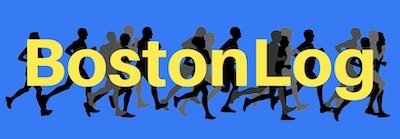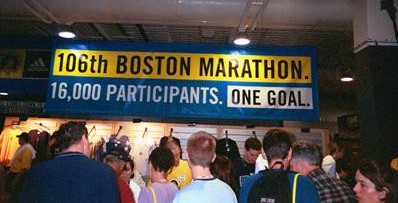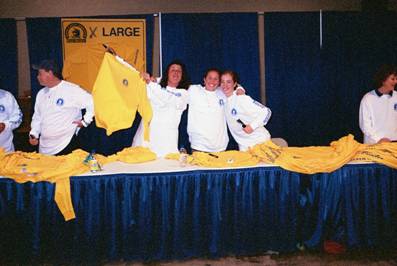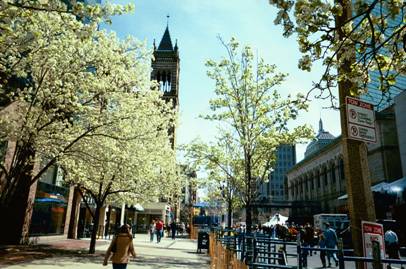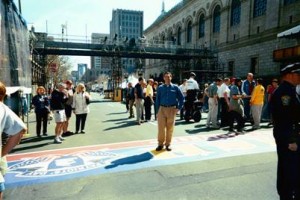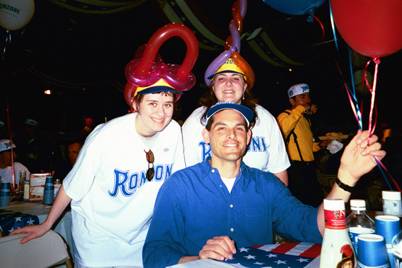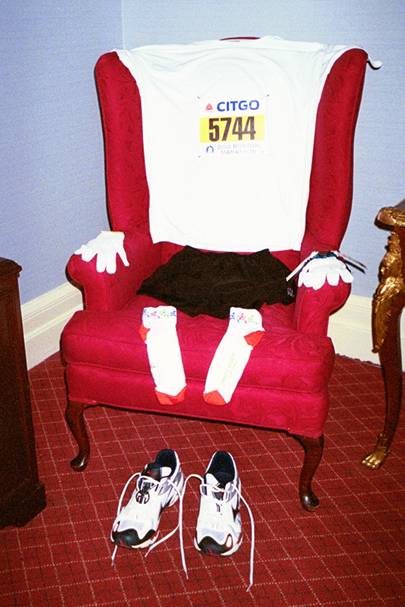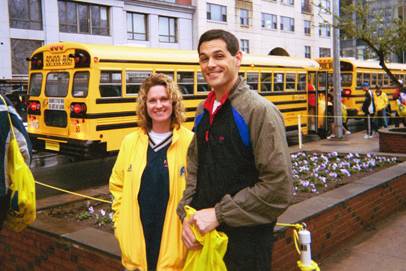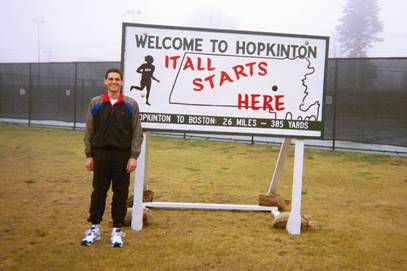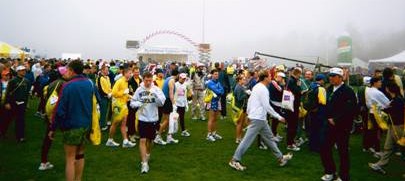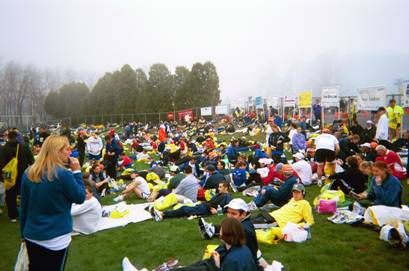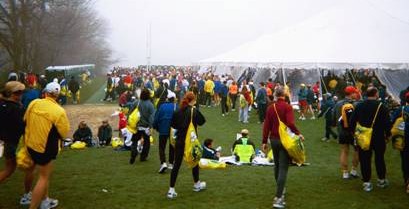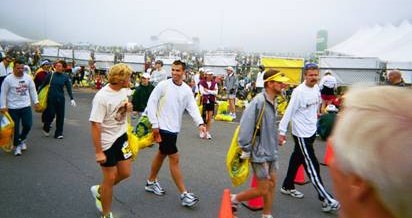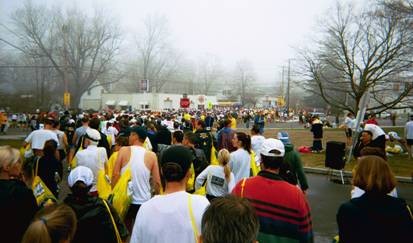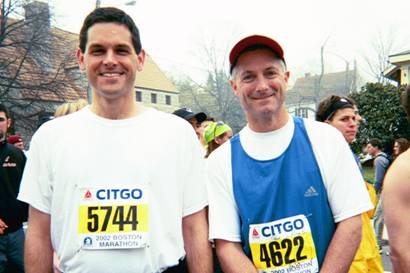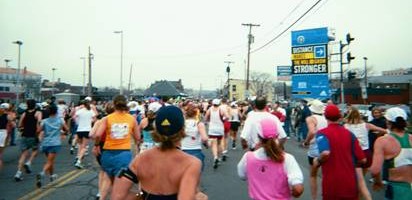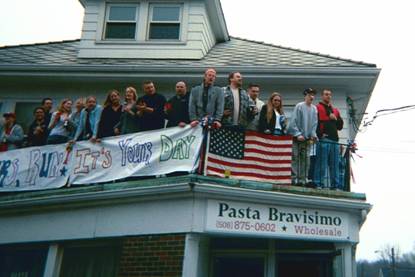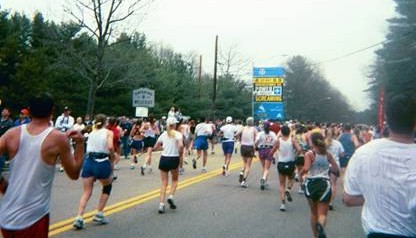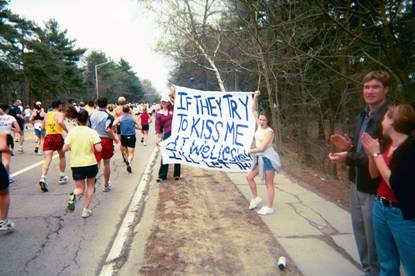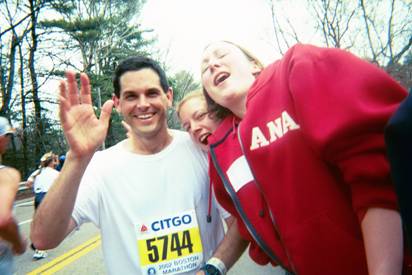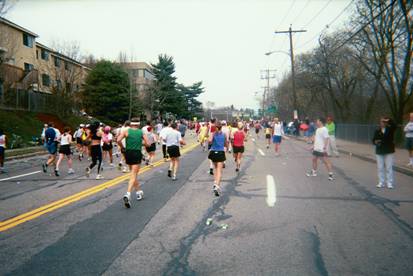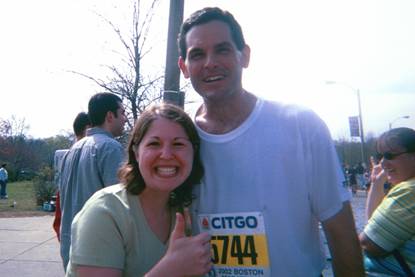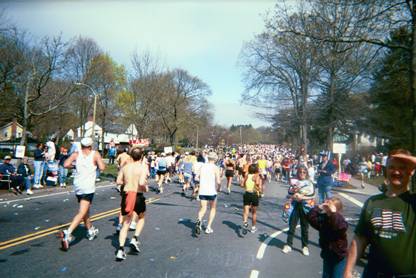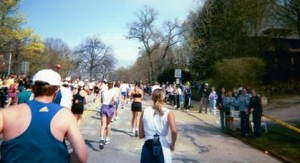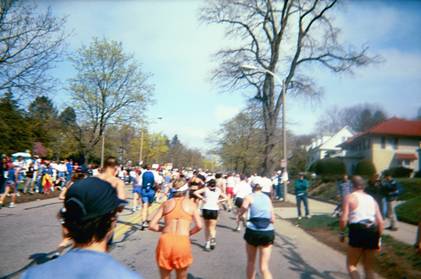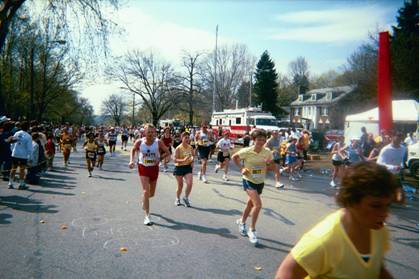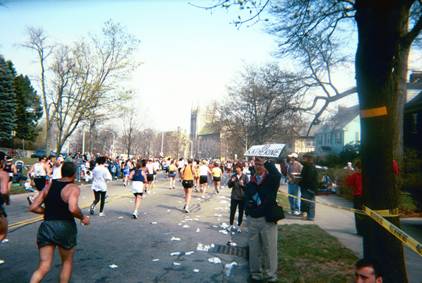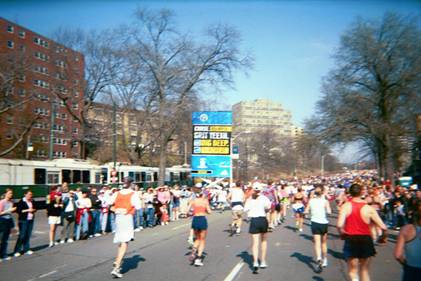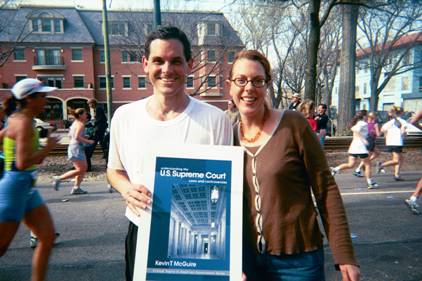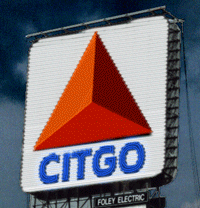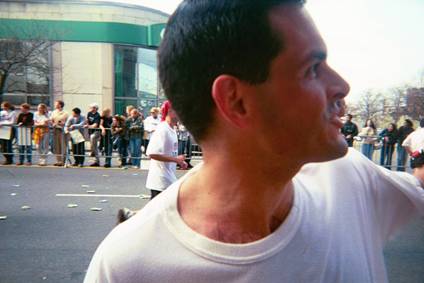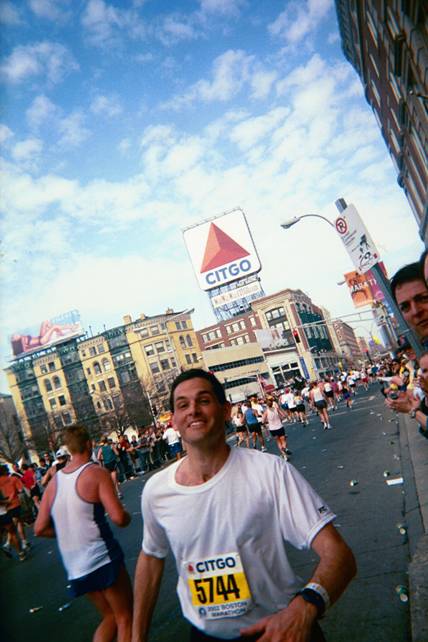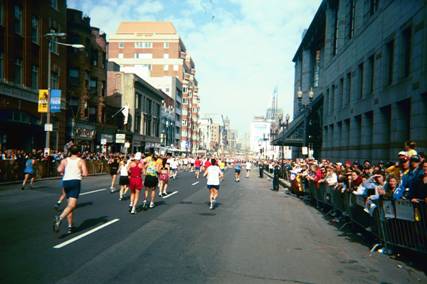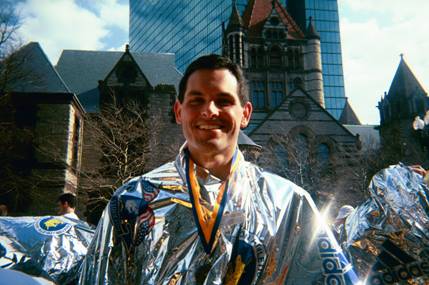The Boston Marathon is perhaps the definitive destination for distance runners. With its tough qualifying requirements, it is the goal to which countless runners aspire. As The Ultimate Guide to Marathons describes it, Boston is “the Mother of all Marathons, running’s best friend,” which “stands as the benchmark by which all other marathons are measured.” It is “unchallenged as the world’s oldest and most prestigious annual marathon.”
I first ran Boston in 2001. A year later, I sought to document some of the race’s special attractions with a personal photo album.
The Marathon Expo
The first stop of the weekend is the marathon expo. Dozens of vendors sell all manner of goods related to running. These include clothing, shoes, souvenirs, books, magazines, pain relievers, foot care items, and an enormous variety of food and drink designed to enhance athletic performance, some tasty (e.g., Clif Bars and Gatorade) and some not so tasty (e.g., Powerbars and Powerade, along with any food whose principal ingredient is rice, in either solid or liquid form).
Packet Pick-Up
No major marathon could function without its volunteers. They provide staff support for the event and do everything from handing out drinks during the race to distributing medals at the finish. As I went through the packet pick-up to collect my bib number, timing chip, and race instructions, these nice women were distributing the most coveted item: the official Boston Marathon T-shirt.
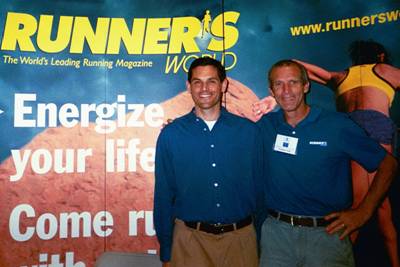
Bart Yasso is one of the senior writer’s at Runner’s World magazine. He’s a very affable guy who offers lots of friendly advice and encouragement. I ran with Bart at the 1999 Chicago Marathon when he led the 3 hour, 10 minute pace team. He brought the runners across the finish line right on time. (Most of them, anyway. One particular member of the group fell off the pace at 18 miles and coasted in a few minutes behind him.)
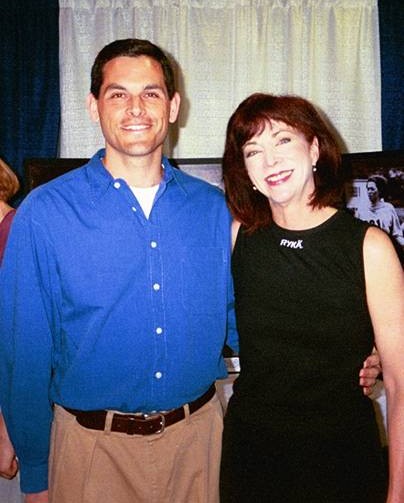
In 1967, Kathrine Switzer became the first woman to run the Boston Marathon. She went on to win the 1974 New York City Marathon and has since worked very vigorously on behalf of women’s running. Not surprisingly, she is a member of the National Distance Running Hall of Fame. In addition to her work as an author and fitness promoter, she frequently serves as a television sports commentator.
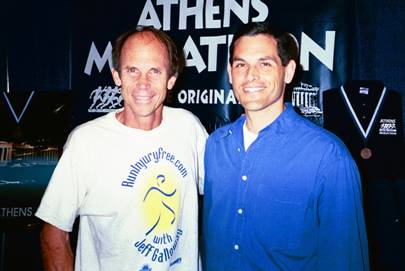
There is probably no more significant figure in the world of distance running than Jeff Galloway. A 1972 Olympic runner, he has been one of the major forces behind recreational running. Through his writing and training groups, he has made the marathon both accessible and enjoyable for countless runners. “Galloway’s Book on Running” is still the standard by which all other running books are measured.
Signs of Spring at the Finish Line
After the expo, I head down Boylston Street to have a look at the finish line. Beyond the trees on the right is the Boston Public Library, where the catwalk that crosses the street already has cameras in place for the next day. As workers prepare the finish line the day before the race, these blooms on the trees hold the promise of pleasant spring weather for the marathon.
A lot of runners will take a snapshot of the finish line the day before the race. On race day itself, ironically, most of us will probably cross it without noticing it. Instead, we’ll have our eyes on the rubber mats that register our timing chips. Plus, the overhead banners and finisher’s clock (not yet in place here), combine with large and loud crowds at the finish to compete for one’s attention.
The Pre-Race Pasta Party
Most major marathons have a pasta party the evening before the race. It gives runners one last opportunity to load up with carbohydrates. Boston offers one of the best organized of these events, and they have a large contingent of good-natured volunteers, such as these nice ladies, who help get you served and seated quickly. Of course, with the North End, Boston is hardly hurting for Italian food, but the event is great fun and a good confidence booster. Plus, Bill Rodgers makes an appearance, which is reason enough to show up. An added benefit is that you are thrown together with strangers at community tables, which gives you a chance to meet runners and their families from all over the country.
Last Minute Preparations
One of the last things many marathoners do the evening before a race is to assemble their running gear across a chair as if they were sitting in it.
It may look a bit odd, but the reason for the layout — bib attached to shirt, shorts, gloves, watch, socks, and shoes with timing chip snugged down — is it eliminates any uncertainty the following morning.
Race Day Transport
Some marathons, like Chicago or the Marine Corps, start and end at the same place. Boston, by contrast, is a point-to-point marathon. So early the next morning, runners have to be bused to the starting line in Hopkinton for the run into downtown Boston. (The timing chip on your shoe and a quick flash of your runner’s bib is your admission ticket for the bus.) The race is wonderfully organized, and the race volunteers manage to get all 16,000 runners transported without a hitch.
“It All Starts Here”
As we step off the buses in Hopkinton, we are greeted by the “Welcome to Hopkinton” sign. Countless runners have been immortalized in front of it, and a good many of us stop here to have our pictures taken before settling into the Athletes’ Village, which is set up on the grounds of Hopkinton High School. From the starting line in Hopkinton, the runners will make their way to Ashland, Framingham, Natick, Wellesley, Newton, Brookline, and end their run in downtown Boston.
Hopkinton Athletes’ Village
Hopkinton is very gracious in playing host to the marathon start. The runners spend the morning in the athletes’ village, which is set-up on the grounds of Hopkinton High School. Not only do they offer bagels, water, Gatorade, and coffee, race organizers also provide entertainment, large-screen televisions, massage, and free long-distance phone calls. Most of us arrive anxious to take advantage of what they have to offer.
Waiting for the Start
Most marathons have an early morning start time — usually between 7:00 and 8:00 a.m. — but Boston does not start until noon. Since buses have been depositing runners here since just after 6:00 a.m., there is a long wait. A few are loose enough to nap, but most runners are pleasantly nervous and thus wide awake. Most of us pass the time simply relaxing and chatting. “Where did you qualify?” is a common conversation starter. Occasionally, you will even encounter someone you know from a previous marathon or your hometown.
In Line for the Port-a-Potty
I once heard John “The Penguin” Bingham, who writes for Runner’s World, give a lecture in which he gave pre-race advice to first-time marathoners. One of his suggestions was to “get in line for the port-a-potty, use the port-a-potty, and then get right back in line again.” Sound advice, I think. Pre-race jitters and the desire to be completely relaxed at the starting line induce multiple visits to the portable facilities. This photo shows just a small number of the toilets. There are dozens more all around the athletes’ village, with long (or longer) lines.
Call to the Starting Line
At about 11a.m., runners are called to make their way to the starting line. We leave behind the Athletes’ Village and head to the center of Hopkinton. Along the way, we’ll deposit those ubiquitous yellow plastic bags in a series of buses, which will transport them to Boston and have them waiting for us just after we cross the finish line.
The Herd
On their way to the start, the runners pretty much overwhelm the little village of Hopkinton. The local population is only around 13,000. So, the town’s size more than doubles once the runners are at the starting line. It’s a very friendly community. Long-time residents invite runners to autograph signs, shirts, and even quilts. Others greet the runners with snacks and drinks in front of their homes, and they display a good-natured tolerance for having out-of-towners traipse across their yards and urinate on their bushes before lining up at the start.
At the Starting Corrals
I spent the morning on the bus and in the Athletes’ Village with Steve Powell, a first-rate marathoner and tremendously nice guy. Here we are, anxious to get underway, just before entering the corrals at the starting line. A few minutes later, the gun sounded and we were off. (We bumped into each other the following morning, when I learned Steve ran an impressive 3 hours, 14 minutes. As I pointed out to him, the rest of us mere mortals do not run a Boston-qualifying time in Boston itself.)
The Framingham Train Depot
After a fast start — the first four miles drop downhill very quickly — runners settle into a steady pace. At this point, most runners are feeling strong and confident. This picture was taken on Waverly Street in Framingham, just before the train depot, which is ahead on the left. Boston prepares these large inspirational signs and places them at various points along the route. It’s a nice touch. This one promises that “distance makes the will grow stronger.”
Crowd Support
Part of what makes Boston so special is the tremendous crowd support that exists all along the course. At other big city marathons, like New York or Chicago, it is not difficult to draw big crowds to cheer runners along most of the route. Boston, however, runs mostly through smaller, less populous areas before ending downtown. Nevertheless, local spectators turn out in large numbers on race day. These marathon enthusiasts, also in Framingham, provide encouragement from their rooftop.
Entering Wellesley
The village of Wellesley is home to Wellesley College, one of the original Seven Sisters colleges that boasts such graduates as Madeleine Albright, Cokie Roberts, and Diane Sawyer. The college plays an important historical role in the marathon, and runners look forward to passing by the college, where students turn out in considerable numbers to offer what is unquestionably the best support along the course.
Good Luck Wishes from Wellesley
Kissing one of the students at Wellesley College is thought to bring a marathon runner good luck. At the entrance to the campus, these women let the runners know they still maintain the tradition.
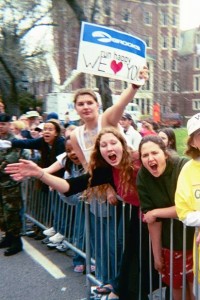
The Scream Machine
There is nothing more motivating along the Boston course than running past Wellesley College. Its special contribution to the race is to offer runners a high-energy wall of sound, and these dedicated women maintain a continuous and deafening scream throughout the entire race. Just past the 12-mile marker, you begin to hear their screams, and by the time you reach the campus itself, the sound is overwhelming. First-timers at Boston may wonder whether the Wellesley students actually provide this kind of volume for the entire race, but the experience of running by the campus leaves no doubt that they do. Other marathons have inspirational moments, but no other marathon experience comes close to this one: the noise is unreal.
A Quick Stop at Wellesley
These Wellesley women — still screaming — took a moment for a photograph with me. They were exceptionally good sports. Anyone amenable to being kissed by a bunch of dirty, sweaty runners would have to be. (I spared them this indignity. The photo was more than sufficient.)
The Newton Hills
The hills of Newton make Boston an especially challenging course. After pounding your quadriceps by running downhill for much of the earlier miles — don’t be fooled; running downhill is hard work — you now give your calves a beating as you climb the Newton Hills. The first one occurs here, where Route 16 crosses Interstate 95. This particular hill is deceiving; it is longer and steeper than it appears, and, since it’s still early in the race, your enthusiasm and confidence can easily get the better of you. As a result, many runners often take this first hill too fast. I learned this lesson quite painfully in 2001.
A Friendly Face
A good many runners plan to meet friends and relatives along the route. It’s always encouraging to see people you know, and knowing where to look for them gives you a goal that helps break the race into more manageable segments. Just after the 19-mile marker, my friend Shannon Morrow, who lives in Boston, was waiting to cheer me on.
Heartbreak Hill, Part 1
As any veteran of the Boston Marathon will tell you, “Heartbreak hurts.” This is the bottom of the infamous Heartbreak Hill. After 20 miles, it poses an extraordinary challenge for even the best trained runners. The last of the Newton hills, it starts here, just past Centre Street, and rises a half mile to the Boston College campus.
Heartbreak Hill, Part 2
It can be difficult to appreciate how steep Heartbreak Hill is, but this picture does a tolerable job of capturing the rise in elevation. Just walking up the hill would take the wind out of most of us, so running it in the late miles of a marathon makes it especially tough. One upside is the crowd support is pretty substantial here. Heartbreak Hill draws a good many spectators, I suspect for the same reason that people slow down to look at a car crash — a macabre fascination with the destruction of the human body.
Heartbreak Hill, Part 3
Because one has to qualify in order to run Boston, the field is not a random sample of runners. These are all determined, experienced runners who ran very competitive qualifying times within the previous eighteen months. In short, these people are in excellent physical shape. Nevertheless, Heartbreak Hill exacts its punishment, and some find that the hill asks more than they are willing to give. Their strategy is to walk, as a few in this photo have chosen to do, and conserve their strength for the remaining miles.
Heartbreak Hill, Part 4
Reaching the top of the hill offers the chance to see runners still climbing those final yards. The marathoners in this picture look impressive, with long strides and pumping arms, both of which are clear signs of strong runners who are moving fast. For those feeling less strong, there is an emergency aid station on the right. On the street, the spent orange peels and crushed paper cups are standard marathon detritus.
Top of the Hill
Even non-believers say a prayer of gratitude to the Jesuits when the spires of Boston College’s Burns Library appear at the top of Heartbreak Hill. When the campus comes into view, you know that it is, quite literally, all downhill from there.
On Commonwealth Avenue
The sign is a bit blurry — I’d already run over twenty miles, after all — but it bears some pretty useful late-race advice: “Grit teeth, dig deep, repeat.” At this point, most runners are feeling fatigued, but we are encouraged by larger crowds as we head into the city. Here we run along the “T” tracks on Commonwealth Avenue as one of the trains passes us on he left.
Encouragement from McGraw-Hill
At 24.5 miles, with Janise Fry. Janise is the marketing manager at McGraw-Hill, publisher of my textbook on the Supreme Court. While other runners are supported with signs bearing the likes of “Go, Dad, Go!” and “Run Like the Wind, Lisa,” I was greeted by a promotional copy of my book cover. Ostensibly, Janise did this to catch my attention as I ran by, but I’m convinced that the real motive was to scare up potential sales among the marathoners.
The Citgo Sign, Part 1
Because it marks the beginning of the final mile of the marathon, the Citgo Sign is one of the most welcome landmarks on the Boston course. Just before the sign, I stopped and asked a young woman to take a photo of me with the sign in the background. In her enthusiasm to be helpful, she snapped this picture as soon as I handed her the camera, while I was still explaining what I wanted her to photograph. There’s lots of drinking on Patriots’ Day, and I think she may have been slightly intoxicated. The odd angle of her second photo suggests indeed she was.
The Citgo Sign, Part 2
Here is the successful photo of the Citgo Sign. From here, runners make their way into downtown Boston. Just before the sign, runners pass Fenway Park to the south, where the Red Sox always have an 11:00 a.m. game on race day. At the sign itself, there is a “bump,” which is marathon-speak for a short but steep rise in elevation. Walking the course, one would hardly notice it, but on race day it kills.
Boylston Street
After the final turn onto Bolyston Street, the finish line is straight ahead. Although one can barely make out the yellow and blue banner spanning the street in this photograph, runners have no trouble picking it out as soon as they round the corner. The crowd support is especially good here, as spectators line up several people deep to watch and encourage the finishers.
The Finish
The volunteer who took the timing chip off of my shoe — it’s extremely hard to bend over and untie your shoes after a marathon — was good enough to take this photograph just moments after crossing the finish line. The Prudential Building, which for the last few miles appears intermittently as a landmark for runners, now stands in the background.
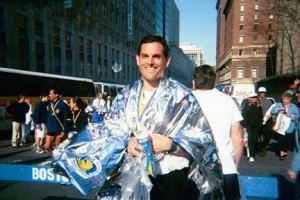
Heading Home
With my finisher’s deal, I pick up my clothes I had deposited on the bus back in Hopkinson. Here I enjoy a warm mylar blanket and a cold drink of water b before walking the two blocks to my hotel, where I take a luxurious shower before catching a cab to Logan Airport for the trip home.
Kevin McGuire
Chapel Hill, North Carolina
April 15, 2002
Age – 38
Bib # 5744
3:55:10
